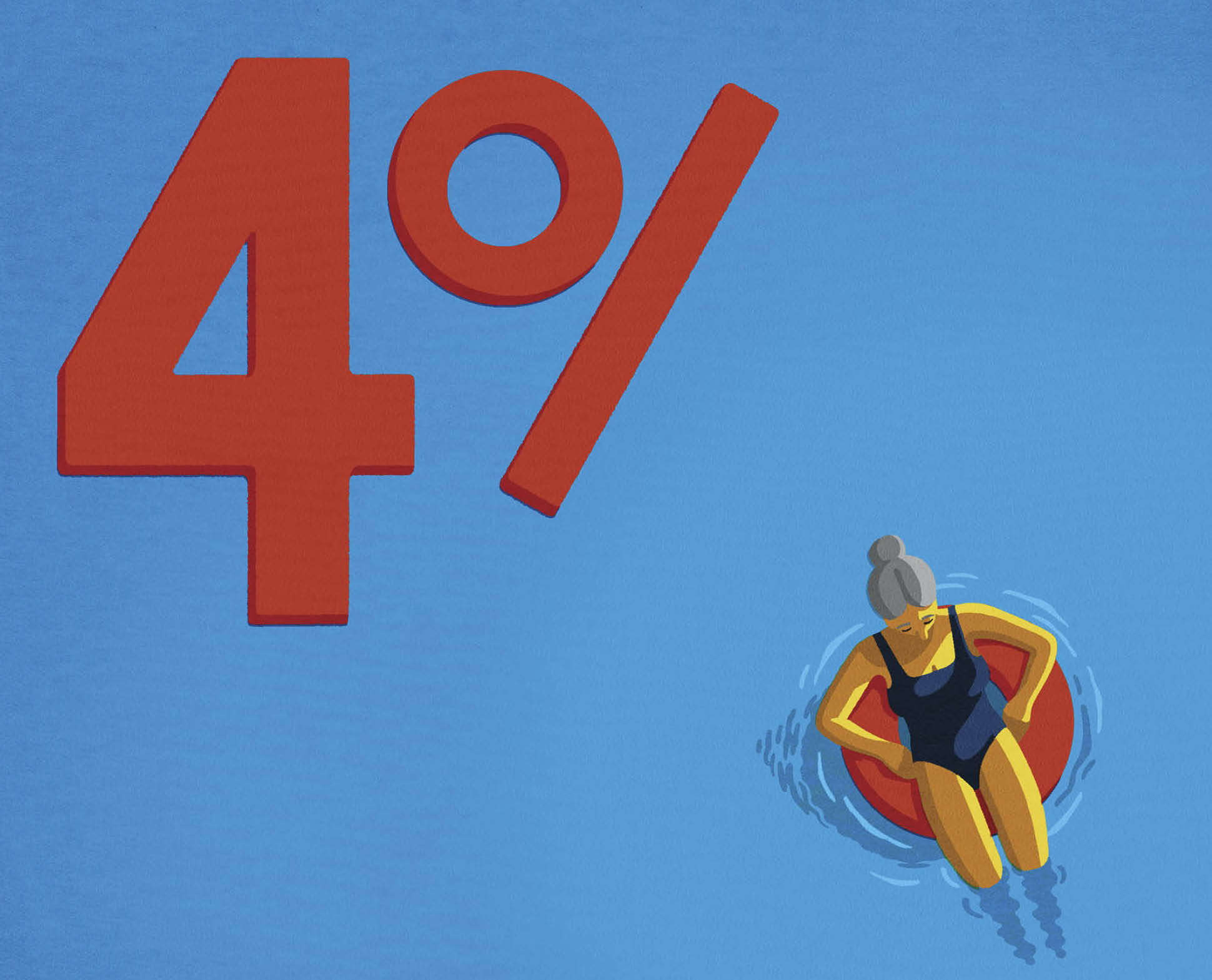BETTER LIVING
Make Your Money Last
These four strategies for managing retirement savings can help ensure you’ll have the cash you need for as long as you live

REMEMBER THOSE brain-twisting math problems from high school? “Two trains leave the station at different times. Train A is traveling at 60 miles an hour. …” You know how they go. But here’s one riddle our teachers never gave us: You retire at 65 years old with $500,000 in savings. How many years can you count on before running out of cash? Yikes! It’s enough to make you nostalgic for the carefree days of train math.
Crunching those numbers has only gotten more difficult with our increasing life expectancies. The average American man can now anticipate living nearly six more years in retirement than his counterpart 50 years ago; the average woman, nearly five more years. That’s fantastic news … assuming you have enough money tucked away. No wonder that a recent survey by research and consulting firm Cerulli Associates found that 58 percent of retirees and pre-retirees said running out of money was their biggest financial fear. To help you make sense of the New Retirement Math, we’ve found some tutors: financial advisers and academic researchers who’ve spent years studying how to safely manage retirement withdrawals. So before you take out your No. 2 pencil to tackle this equation, check out four retirement income strategies they’ve developed to maximize your spending while minimizing the risk of emptying your bank account.

THE 4 PERCENT RULE
• In plain English: Withdraw 4 percent of savings the first year and increase annually with the inflation rate.
• The gist: During your first year of retirement, you can withdraw up to 4 percent from your retirement stash, be it IRAs, 401(k)s or other accounts. With each subsequent year, increase those withdrawals based on the rate of inflation. So if you have $500,000 in retirement savings, you’d withdraw $20,000 during your first year. The next year, if the inflation rate is 3 percent, you’d withdraw $20,000 plus 3 percent of $20,000—or $600—for a total of $20,600.
• Behind the strategy: Bill Bengen, a financial adviser and researcher, came up with the 4 percent rule in the early 1990s in an effort to determine how to make a simple retirement portfolio—one invested half in large-company U.S. stocks and half in government bonds—last over a 30-year period, even when markets were at their worst. He’s fine-tuned it over the years. By adjusting the balance to 55 percent stocks and 45 percent bonds and adding international and small-company stocks to the mix, he says you can increase your initial withdrawal to 4.7 percent.
• Drawbacks: Old research yields old results. Bengen’s calculations were tested on past market performance, so an unprecedented or prolonged stock-market downturn could throw off the math. And because the rule is designed expressly to withstand worst-case scenarios, you could end up with a lot of unspent (and unenjoyed) wealth in your later years if the markets stay healthy.
• Consider it if …: You want a simple calculation with risk low enough to help you sleep at night.

THE GUARDRAILS APPROACH
• In plain English: Treat yourself, but watch the markets and bring your pocket calculator.
• The gist: You start out with a first-year withdrawal of 5.3 percent, with 60 to 70 percent in stocks. Then, each subsequent year, you calculate a new annual withdrawal based on how much your portfolio has gone up or down and what the inflation rate is. As a result, your annual withdrawal may go up, stay the same or even get slashed.
• Hypothetical example: During your first year of retirement, you withdraw $26,500, which is 5.3 percent of your $500,000 retirement account. The next year, you adjust that initial amount for inflation. Often, that will be your new withdrawal amount; if the inflation rate is, say, 3 percent, your new number will be $27,300. But before proceeding, you compare that new number to your portfolio’s year-end value. Then, depending on whether it’s been a particularly good or bad year for your investments—that is, whether you’ve hit a “guardrail” preventing you from going too far off course—your second-year withdrawal could be very, very different. How different? In this example, it could drop to $24,600 (down about 7 percent from year one) or jump to $30,000 (up 13 percent).
• Behind the strategy: Jonathan Guyton, a financial planner at Cornerstone Wealth Advisors in Minneapolis who codeveloped this system, says he wanted to see how much more you could withdraw if you were willing to be more flexible. Guyton has been using this method with his own clients for more than a decade. “No one has had to significantly change their lifestyle or worry about whether their retirement income plan was a ticking time bomb,” he says.
• Drawbacks: So … much … math! And unlike acing your SATs, your hard work won’t always be rewarded. “There’s no free lunch,” says Guyton. “When one of the adjustments gets triggered, you have to take your medicine.” To prepare for the years when you get a retirement pay cut, Guyton suggests setting aside a little extra money.
• Consider it if …: You want to start with a larger payout but don’t mind doing the math (or working with a financial adviser).

RMD GUIDELINES
• In plain English: What would the IRS do?
• The gist: If you have money in a tax-deferred retirement account such as an IRA or 401(k), the IRS will leave it alone only for so long. Eventually—it starts with the year you turn 73, for most people—you’ll have to withdraw a certain amount of money. That withdrawal is what’s known as a required minimum distribution (RMD). The RMD approach uses the IRS formula for what you must withdraw from these tax-deferred accounts as a guideline for what you can withdraw from all your retirement accounts, whether they’re subject to RMDs or not. Think of the IRS as the smart kid in the seat next to you in math class, and you’re copying her answers.
But you don’t have to cheat. That formula, built on your age and your account’s value, is drawn from what’s known as a Uniform Lifetime Table, which you can find at irs.gov in IRS Publication 590-B.
• Behind the strategy: The IRS tables are designed to clear out your account based on your life expectancy. The formula for age 73 translates into withdrawing 3.8 percent of your account balance at that age (that’s $19,000 out of a $500,000 account), and the percentage gradually increases each passing year—for example, reaching 5.6 percent at age 83.
“It’s a conservative spending number, but that can give you a guideline,” says Wade Pfau, author of Retirement Planning Guidebook and a professor at the American College of Financial Services. “If I’m spending this percentage of what’s left in my portfolio, based on the RMD table, then I should be in pretty good shape. If you’re spending a lot higher than the RMD rate for your age, that’s potentially dangerous.”
• Drawbacks: This isn’t the plan if you’re hoping for a retirement splurge. It can also be tricky to figure out what you should be withdrawing prior to turning 73. Using the IRS’s math, you should be withdrawing 2.9 percent at 65. That’s considerably less than what most people want to spend in their first year of retirement; people tend to spend more in the early years of retirement and less later on, unless they have large expenses for medical or daily care later in life.
The withdrawal amount can also vary a lot based on market performance. “You’re guaranteed never to run out of money, but you still might be poorer than expected,” says Anthony Webb, a senior research fellow at The New School.
• Consider it if …: You don’t mind a frugal lifestyle if it means you’ll have enough money to stay afloat for the long haul.

ANNUITIZATION
• In plain English: Let someone else handle your retirement paycheck.
• The gist: Buying an income annuity is like hiring someone to serve as your retirement “boss,” doling out a monthly paycheck. You hand over a large lump sum to an insurance company, or sometimes a charity, which then guarantees to pay you a certain amount of monthly income no matter how long you live. One big plus: Often, the monthly income from an annuity may be larger than the amount you can safely withdraw from your retirement investments using the other strategies. For example, a 65-year-old male spending $100,000 on an immediate annuity, at current prices, might get back $7,600 in year one, or 7.6 percent of the price—a lot more than the withdrawal percentages in the previous strategies described.
• Behind the strategy: Some of the benefits are psychological: Research has found that people who have a company pension are happier than those who rely on pulling cash from retirement accounts. It’s comforting to have money automatically deposited into your account on a predictable timetable; you may have retired from a job but not from the security of a check deposited in your account like clockwork.
Don’t forget that Social Security is an annuity too; the longer you wait to begin taking it, likely the better off you will be financially, given that payment levels increase up to 8 percent for each year you delay beyond full retirement age. “The act of postponing claiming Social Security is economically equivalent to purchasing an annuity,” says Webb. Unless you’re in poor health, his usual recommendation is to use your 401(k) money upon retirement to delay claiming Social Security until 68 to 70.
Most academics recommending annuities prefer the plain-vanilla immediate or deferred versions, not the more complex (and expensive) versions like variable annuities or indexed annuities. Two kinds of income annuities provide extra tax benefits.
• Charitable gift annuity. In return for a lump sum you donate to a nonprofit organization, you receive a fixed amount for the rest of your life. If you itemize, a portion of your contribution is deductible. Alternatively, a new law lets people make a tax-free transfer of up to $50,000 from an IRA to buy a charitable gift annuity—money that can also count toward an RMD.
• Qualified longevity annuity contract (QLAC). This is a type of annuity sometimes referred to as longevity insurance; payments don’t start until you reach a much older age. “You buy it for the same reason as purchasing a household insurance policy,” says Webb. “It’s insurance against the small but financially catastrophic ‘risk’ of living to age 95 to 100.” A key benefit is that the delayed onset of annuity payments translates into much higher monthly income. For example, a 65-year-old man who invests $200,000 in a New York Life QLAC could receive about $9,400 per month starting at age 85, or more than $112,000 per year. A 65-year-old woman could receive $7,400 per month, or nearly $89,000. You can take up to $200,000 from a tax-deferred IRA or 401(k) to buy a QLAC, which removes the money from the amount used to calculate your RMDs.
• Drawbacks: Unlike Social Security, most annuities aren’t adjusted for inflation. You also lose access to your lump sum, so if you don’t have a nest egg to cover emergency expenses, you could be in trouble. Oh, and you may die before receiving many payments—or any, in the case of a QLAC.
• Consider it if …: You care more about guaranteed income than leaving money in an estate, and you’re willing to hand over a lump sum to an insurer. Charitable gift annuities are good if you’d like to make a gift to a nonprofit while you’re alive, but still need retirement income. QLACs can help if you have high balances in tax-deferred retirement savings and face big tax bills once you start taking RMDs.
More Tips for Making Money Last

Be boring.
Make investing as boring as possible. Boring works really well. The less often that people check and adjust their portfolios, the better they tend to perform. Just dumping money into a target-date fund in your 401(k) or IRA every month—and then leaving it alone—is a great investment strategy.
—Mike Piper, author of Investing Made Simple: Index Fund Investing and ETF Investing Explained in 100 Pages or Less and other financial books

Rehearse retirement.
A past client and her spouse were a year away from retirement. To ensure they were comfortable with their postretirement spending plan, they started splitting their takehome pay between two checking accounts. Into Account #1 went the money they needed for nonnegotiable fixed expenses such as mortgage, utilities and insurance premiums. Account #2 received whatever was left over, after a deduction to savings that mimicked their expected decreased cash flow in retirement. They did their everyday spending out of Account #2; when that pot of money was done, so was their spending. It was a great way to test-drive their retirement plans and make sure they were realistic.
—Lisa Whitley, personal finance coach at MoneyByLisa in Washington, D.C.

Cut the allowance.
Parents may have been helping their children throughout their lives, so they often have a hard time stopping once their children are adults. The problem is that supporting your kids can ruin even the best retirement plan. In my personal life, I’ve witnessed many grown adults move back home with their retired parents and constantly request assistance. That retired couple should be downsizing for their health and lifestyle benefit, but are not able to because they can’t stop helping their grown children.
—Tim Mazanec, financial adviser with Allworth Financial in Waltham, Massachusetts

Pay it all down.
Don’t carry debt or a mortgage into retirement. Not having these things to worry about reduces your stress and keeps your retirement expenses much lower. What better way to make savings last a lifetime than by not needing as much each month to cover your expenses? I’ve seen this with many clients in my practice.
—Peter G. Bobolia, financial planner at Family First Financial Planning in Stuart, Florida
Kimberly Lankford, a former columnist at Kiplinger’s Personal Finance, is the author of Rescue Your Financial Life.